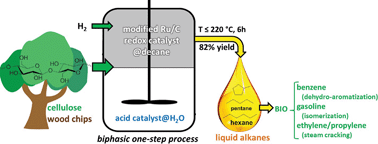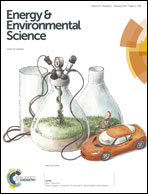Direct catalytic conversion of cellulose to liquid straight-chain alkanes†
Abstract
High yields of liquid straight-chain alkanes were obtained directly from cellulosic feedstock in a one-pot biphasic catalytic system. The catalytic reaction proceeds at elevated temperatures under hydrogen pressure in the presence of tungstosilicic acid, dissolved in the aqueous phase, and modified Ru/C, suspended in the organic phase. Tungstosilicic acid is primarily responsible for cellulose hydrolysis and dehydration steps, while the modified Ru/C selectively hydrogenates intermediates en route to the liquid alkanes. Under optimal conditions, microcrystalline cellulose is converted to 82% n-decane-soluble products, mainly n-hexane, within a few hours, with a minimum formation of gaseous and char products. The dominant route to the liquid alkanes proceeds via 5-hydroxymethylfurfural (HMF), whereas the more common pathway via sorbitol appears to be less efficient. High liquid alkane yields were possible through (i) selective conversion of cellulose to glucose and further to HMF by gradually heating the reactor, (ii) a proper hydrothermal modification of commercial Ru/C to tune its chemoselectivity to furan hydrogenation rather than glucose hydrogenation, and (iii) the use of a biphasic reaction system with optimal partitioning of the intermediates and catalytic reactions. The catalytic system is capable of converting subsequent batches of fresh cellulose, enabling accumulation of the liquid alkanes in the organic phase during subsequent runs. Its robustness is illustrated in the conversion of the raw (soft)wood sawdust.

- This article is part of the themed collection: 2015 most accessed Energy & Environmental Science articles

 Please wait while we load your content...
Please wait while we load your content...